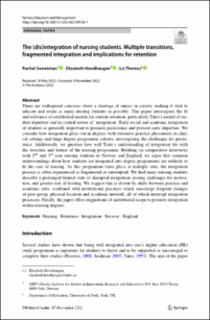| dc.contributor.author | Sweetman, Rachel | |
| dc.contributor.author | Hovdhaugen, Elisabeth | |
| dc.contributor.author | Thomas, Liz | |
| dc.date.accessioned | 2023-01-20T13:37:57Z | |
| dc.date.available | 2023-01-20T13:37:57Z | |
| dc.date.created | 2023-01-04T09:19:20Z | |
| dc.date.issued | 2022 | |
| dc.identifier.citation | Tertiary Education and Management. 2022, . | en_US |
| dc.identifier.issn | 1358-3883 | |
| dc.identifier.uri | https://hdl.handle.net/11250/3044991 | |
| dc.description.abstract | There are widespread concerns about a shortage of nurses in society, making it vital to educate and retain as many nursing students as possible. This paper interrogates the fit and relevance of established models for student retention, particularly Tinto’s model of student departure and its central notion of ‘integration’. Early social and academic integration of students is generally important to promote persistence and prevent early departure. We consider how integration plays out in degrees with extensive practice placements in clinical settings and large degree programme cohorts, investigating the challenges for persistence. Additionally, we question how well Tinto’s understanding of integration fits with the structure and format of the nursing programme. Building on comparative interviews with 2nd and 3rd year nursing students in Norway and England, we argue that common understandings about how students are integrated into degree programmes are unlikely to fit the case of nursing. As this programme takes place at multiple sites, the integration process is often experienced as fragmented or interrupted. We find many nursing students describe a prolonged liminal state of disrupted integration, posing challenges for motivation, and greater risk of leaving. We suggest this is driven by shifts between practice and academic sites, combined with institutional practices which encourage frequent changes of peer group, physical location and academic network, all of which interrupt integration processes. Finally, the paper offers suggestions of institutional scope to promote integration within nursing degrees. | en_US |
| dc.language.iso | eng | en_US |
| dc.title | The (dis)integration of nursing students. Multiple transitions, fragmented integration and implications for retention | en_US |
| dc.title.alternative | The (dis)integration of nursing students. Multiple transitions, fragmented integration and implications for retention | en_US |
| dc.type | Peer reviewed | en_US |
| dc.type | Journal article | en_US |
| dc.description.version | publishedVersion | en_US |
| dc.source.pagenumber | 0 | en_US |
| dc.source.journal | Tertiary Education and Management | en_US |
| dc.identifier.doi | 10.1007/s11233-022-09106-7 | |
| dc.identifier.cristin | 2100176 | |
| cristin.ispublished | true | |
| cristin.fulltext | original | |
| cristin.qualitycode | 1 | |
